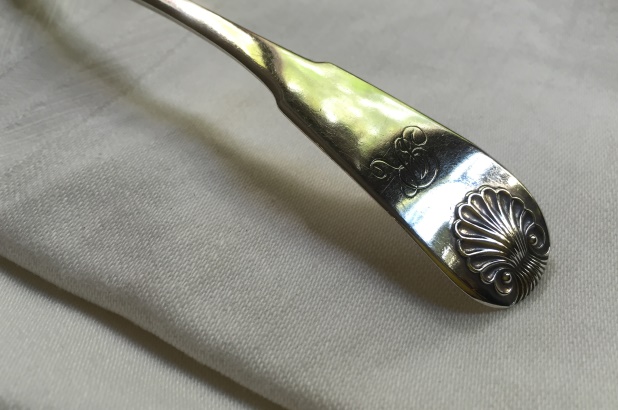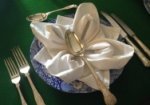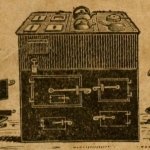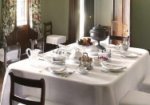This week John Macarthur is heading home to Sydney after eight years away. That’s means it’s time to go shopping!
Getting lost in the Macarthur archive is quite easy. Sitting near my desk at Elizabeth Farm are a row of folders crammed with excerpts painstakingly put together by historian Joy Hughes (who deserves a medal for her skills at transcribing 19th century scrawl). You may dive into one looking for information on the house, but by the time you close it again you’ll know what colour jacket the butler wore (blue), how much the Chinese cook was paid (£1-5 a month), when the foundations of the new kitchen were being dug (and by who), how often a sheep was killed for mutton (weekly) and what was going onto the dining table when it was set.
Home again, home again
In London, 1817, John Macarthur finally received word that he could go home to his wife after 8 years in exile. He was certainly not the same man who had arrived years ago to argue his and the rebels side of the overthrow of Governor William Bligh. Chastenned and exhausted, and promising not to involve himself in colonial politics (Ha! Like THAT was ever going to hold) he and his sons James and William were set to board the Lord Eldon in late April.
With only a few weeks left before they departed John went shopping. This was a pretty standard thing to do; it was common practice for colonial families visiting Britain to sell up before they left, then come back 2 years later with all sorts of up-to-date homewares – furniture, clothes, artworks, and some extra crates of fashionable goodies to sell on arrival. And after all, the Macarthurs (thanks to Elizabeth’s efforts in New South Wales as John piloted the ‘HMS Macarthur’ by remote control) were now in a far better position economically than they had been in 1790, when they first arrived in the colony.
Elizabeth Farm in the early 1820s; detail of published view by Joseph Lycett. Sydney Living Museums, Elizabeth Farm collection
As a leading family of the colonial gentry the Macarthurs needed to present a stylish estate, garden and house, and set a fine table; the house would do for a few years more until John began to rebuild that into the bungalow we see today (in the contemporary view by Joseph Lycett, above, the dining room is behind the two windows to the right of the central front door). As for their table, they may have used chinaware before, but now it was to be silver plate.
At Docknray & Norman’s, Leicester Square.
Dated 25th March, 1817, a two-page receipt from ‘Docknray & Norman, Goldsmiths & Jewellers of Princes St., Leicester Square’ (London) details a considerable purchase – a shopping trip that totaled just over 329 pounds! While there are a few household goods, silverware dominates, and from that we get an excellent idea what was now to be on the family table each day, and locked away in the butler’s pantry each night.
While period texts say the optimum number for dinner in a large household was 14, John acquired a set for 12. It’s actually impossible to imagine a table large enough for 12 in the Elizabeth Farm dining room as at that time it would have completely filled the room! The extensions that would take in the enclosed verandah and create the room’s apsidal end were still a decade away. In its original, roughly square plan, the room was around 4.9 by 5.2 meters, around 16 feet square. The dining table itself would then have been a pair of D-ends with middle insert, like that at Rouse Hill.
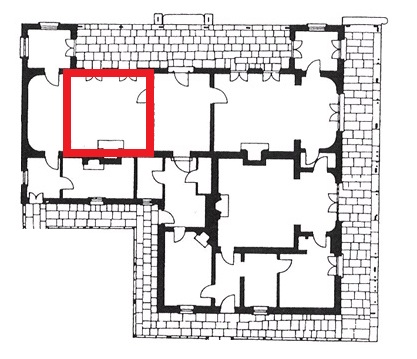
Plan of Elizabeth Farm highlighting the extent of the original dining room
A set for 12 would have easily accommodated the framily’s daily needs – on Macarthur’s return to Parramatta there were six children resident at the house (and James and William were soon relocating to Camden) along with Penelope Lucas – and small parties of guests. Curiously though, a larger set had actually been acquired by Elizabeth Macarthur only a few years earlier; in November 1815 she ordered through close contact Walter Davidson in Canton (Guangzhou), China, 1 teapot, 24 each of teaspoons, table spoons and forks, 12 each dessert spoons and forks, and a fish slice, totaling just over 300 pounds. If you went to the Eat Your History: a shared table’ exhibition you may remember some of these were on show in the Macarthur ‘breakfast table’ display.
The set acquired by John is a standard set for a middle class household, albeit all in silver plate rather than than serving dishes in ceramic. It included (with prices in pounds, shillings and pence):
1 x 23 inch venison dish (ie for carving at the table) 16-5-0
1 x 23 inch meat dish silver 13-0-0
2 x 20 inch meat dish silver 17-17-0
3 x 18 inch meat dishes 13-13-0
1 x 22 inch oblong plated waiter (a serving tray used inside the house) 12-5-0
2 oval plated fluted dish covers 11-11-0
2 oval soup tureens 35-0-0
4 butter tureen to match 18-18-0
4 oval double ragout dishes 27-6-0
4 oblong vegetable dishes 26-5-0
Oblong fluted bread basket 6-6-0
6 Fid[dle] & Sh[ell] Table spoons 6-18-0
12 dessert spoons 8-8-0
12 table forks 14-14-0
12 dessert forks 9-9-0
2 Fid[dle] & Sh[ell] salt ladles 0-14-0
Pair asparagus tongs 2-15-0
1 x 11-inch Plated S[ilver] Knive [sic] 0-8-6
1 x 13 inch D[itt]o. 0-9-6
Pair fluted bottle stand 1-12-0
Pair salts [salt cellars] gilt inside 1-14-0
Gilt bowls 2-5-0
Spoons for do. 1-10-0
1 doz plated dessert knives and forks 14-14-6
So to put things into perspective, a single table fork cost around 2 pounds 8 shillings. Not a trifling sum in 1817 – remember the cook was paid 1 pound 5 shillings a month. I’m curious about the ‘double ragout’ dishes, which might be a dish with side-by side compartments. Most items also nominate a second cost, for engraving the family’s full arms – crest, shield and motto ‘Fide et Opera’ – on larger items, and the crest alone on cutlery. The crest is the olive wreath I’ve talked about previously.
What may be a secondary set of everyday cutlery also appears, listed as “dozen Black handled Knives and Forks” (10 shillings sixpence), “1 doz. Do. (ie the same as the above) dessert” (9 and 6), and a “pair of carvers” (5 and 6). These seem so cheap in comparison that they may have been for the household staff. And while we’re shopping… Docknray & Norman had a varied line of products: Macarthur also bought some picture glass for two frames, and towards the end of the receipt we also read “a “single barrel Gun “ and “2 gun covers”.
Fiddles, shells and threads – oh my!
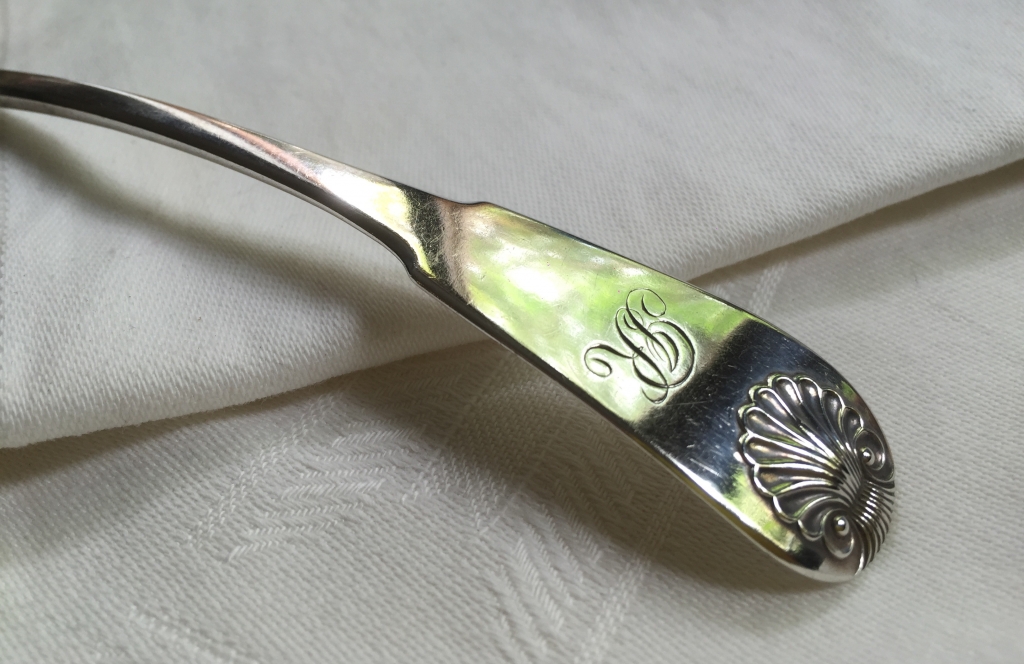
Detail of a sauce ladle handle in fiddle and shell pattern. Photo (c) Scott Hill for Sydney Living Museums
The invoice is dotted with references to style: gadrooning on the serving dishes for instance. The first of the table cutlery nominates ‘Fiddle and shell’ (the rest of the set all start with ‘Do.’, short for ‘ditto’ and meaning the same as above). The ‘Fiddle’ pattern is one of the most recognisable designs for silverware, becoming popular in Britain in the later 1700s and especially in the early 1800s. It derives its name from the way the neck and flared head (loosely) resemble those of a violin (or fiddle).
By adding a thin line or 2 around the edge you achieve the ‘fiddle and thread’ pattern. With a shell you have the (no points for guessing) ‘fiddle and shell’, which is that nominated in the Macarthur receipt and pictured here. Combine all three for the ‘fiddle, thread and shell’. The set acquired by Elizabeth from canton were all in fiddle, shell and thread, with the engraved crest.
Provenanced to Governor Richard Bourke the part set below is in the slightly older ‘Old English’ style, where the handle simply flares outwards and which curves down slightly. The one exception is the single fish knife on the bottom row which is in the newer, basic Fiddle style.
Cutlery provenanced to Governor Bourke, by silversmith Matthew Boulton. Museum of Sydney Collection, Sydney Living Museums
Finally home
Macarthur and his sons arrived back in Sydney harbour on the morning of the 30th of September. He quickly penned a letter to Elizabeth which was sent post-haste to Parramatta:
My dearest best beloved Elizabeth.
We are at last safely at anchor within the Heads and waiting most impatiently for the appearance of Captain Piper. We met the Matilda and learnt from Captain Humphreys who came on board us that you are all well. This most welcome news has made us bear with tolerable patience a most annoying adverse wind. James and William will hasten to you the moment they can procure a conveyance. I must follow at a slower pace, for to speak the truth fast movements will not suit me – not to keep you in suspense, I am returned to you with the most severe fit of gout – it has lasted a fortnight and I think will take leave soon – Home will do more for me than the doctor – how many dear associations does that word Home create. For a short time adieu,
Your affectionate Macarthur
It cannot have been long until the crates had arrived and were unpacked and a celebratory dinner was held, with the candlelight glinting on the family’s splendid new dinner service.
PS
John Norris dug the kitchen cellar.
Captain Piper was the harbourmaster, a friend of the family, and threw some really great parties at his harbourside villa till the money dried up in spectacular fashion.
The Chinese silver bought in 1815 bears pseudo-hallmarks, which sets it apart from that ordered in London.
For more on the Macarthurs and dining you may enjoy ~
Setting the Macarthur’s table at the Spring Harvest festival
